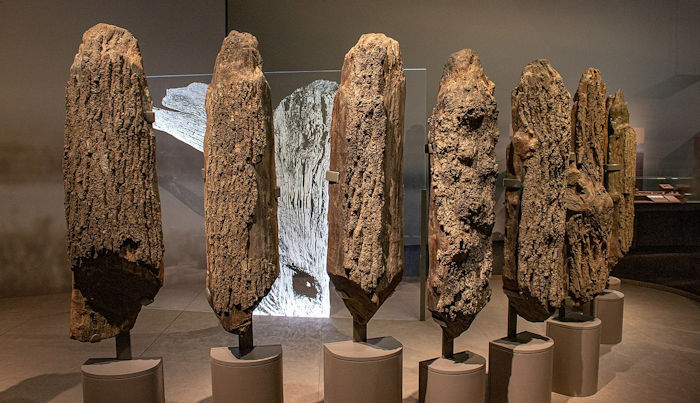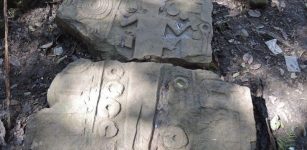Was 4,000-Year-Old Seahenge In Norfolk Built To Battle Climate Change?
Jan Bartek - AncientPages.com - One of the most extraordinary archaeological discoveries of recent times was the uncovering of the so-called Seahenge off the north coast of Norfolk, United Kingdom.
This enigmatic 4,000-year-old structure, discovered in 1998, marked a groundbreaking moment in Bronze Age archaeology. Preserved in the shifting sands of Holme Beach on the North Norfolk coast, the unique timber circle, aptly named Seahenge, resembles the iconic Stonehenge in Wiltshire.
Holme I timber enclosure with central inverted oak stump. Credit: Mark Brennand
The purpose of Seahenge has never been determined, but there are speculations, of course.
One theory states that the upturned tree stumps were put there so dead bodies could be laid on top and birds and animals could pick away the flesh and bones. Yet, another suggestion is that the structures may have been erected to mark the death of an individual.
A new study by University of Aberdeen researcher Dr. David Nance proposes that Seahenge was created in response to extreme climatic deterioration at the close of the third millennium B.C.
The circle, consisting of an upturned tree stump surrounded by 55 closely fitted oak posts, was initially constructed on the saltmarsh, away from the sea. Specialists estimate that the timbers used in its construction date back to the spring of 2049 BC. Initially, the circle was positioned in an area protected from the sea by sand dunes and mud flats. This swampy environment created a layer of peat that gradually covered the timbers, preserving them from decay.
Dr. Nance also examined Holme II, a second adjacent ring dated to the same year, centered on two flat oak logs. In his study, he considered the archaeological evidence from both sites, along with climatic and environmental data, astronomical and biological evidence, regional folklore, and toponymy (the study of place names).
In his paper, Dr. Nance proposes an alternative explanation, suggesting that Seahenge and the adjacent timber circle were constructed during a period of extreme cold climate. He posits that these structures were built for rituals aimed at prolonging the summer season and facilitating the return of warmer weather conditions.
Dating of the Seahenge timbers showed they were felled in the spring, and it was considered most probable that these timbers were aligned with sunrise on the summer solstice.
We know that the period in which they were constructed 4,000 years ago was a prolonged period of decreased atmospheric temperatures and severe winters and late springs placing these early coastal societies under stress.
It seems most likely that these monuments had the common intention to end this existential threat but they had different functions," Dr. Nance explains.
Seahenge (Holme I) in the temporary exhibition "The World of Stonehenge" at the British Museum. Credit: JvL - CC BY 2.0
"The contribution of folklore, including rituals and social customs, ‘weather wisdom’ and the world-views of present-day indigenous societies also provides alternative conceptions of climate change; for example, those of Inuit, Amazonian, and Melanesian peoples. While people generally readily adapt to minor or seasonal climatic fluctuations, significant long-term, local and global changes pose problems to which the options, responses and adaptations of such diverse societies have been varied and localized.
However, the rituals and social customs of prehistoric societies associated with earlier climate change events, with few traces in the archaeological record, can rarely be ascribed. These illiterate societies remember such events as orally-transmitted myths and legends," Dr. Nance writes in his study.
He points to Seahenge's alignment with sunrise on the summer solstice and suggests that its function was to mimic the "pen" described in folklore for an unfledged cuckoo, to keep the birds singing and thereby extending the summer.
"Summer solstice was the date when according to folklore the cuckoo, symbolizing fertility, traditionally stopped singing, returned to the Otherworld and the summer went with it," Dr. Nance added.
The monument's form appears to imitate two supposed winter dwellings of the cuckoo remembered in folklore: a hollow tree or 'the bowers of the Otherworld' represented by the upturned oak-stump at its center.
This ritual is remembered in the 'myth of the pent cuckoo' where an unfledged cuckoo was placed into a thorn bush and the bird was 'walled-in' to extend the summer but it always flew away," Dr. Nance says.
The interpretation proposed by Holme II draws upon ancient legends from Iron Age Ireland and northern Britain, which recount the existence of 'sacred kings' who were sacrificed in the event of calamities befalling the community. This practice, as exemplified in the case of Holme-next-the-sea, was undertaken as a ritual to appease the goddess Venus, to restore harmony and prosperity to the afflicted populace.
See also: More Archaeology News
He said, "Evidence suggests that they were ritually-sacrificed every eight years at Samhain (now Halloween) coincident with the eight-year cycle of Venus.
"The fixtures in Holme II that were thought to hold a coffin, are orientated towards sunrise on Samhain in 2049 when Venus was still visible.
"Both monuments are best explained as having different functions and associated rituals, but with a common intent: to end the severely cold weather."
The study was published in GeoJournal
Written by Jan Bartek - AncientPages.com Staff Writer






















